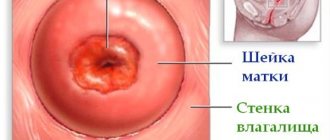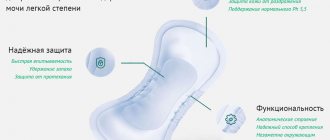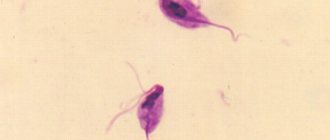The female body is truly amazing. The changes that occur in it during pregnancy and childbirth cannot but surprise. And what is most interesting is that after childbirth everything gradually falls into place, and the body prepares for a new pregnancy with the same changes.
Childbirth is an absolutely natural process for which the entire body as a whole is responsible, but still the “center of events” is the uterus. It is in it that a little person grows and develops for 9 months; it is in it that it changes the most during pregnancy and after delivery it becomes an open bleeding wound that must heal and return to its previous “life.” The placenta, together with the fetus, releases the uterus, breaking with the endometrium (the upper layer of the uterine cavity), and since these two important organs were “connected” by numerous blood vessels, it is natural that the process of their “rupture” is not complete without blood in the literal sense of the word. After childbirth, a woman’s uterus begins to return to its previous “shape”, pushing out everything superfluous and unnecessary, which women call postpartum menstruation, and doctors call lochia.
What does Lohia look like?
Lochia contains a sufficient amount of blood, so it will come out periodically in small quantities.
Using tampons in the first six weeks increases your risk of getting an infection.
You will have to wear thicker maternity pads, and you may miss a small piece of placenta or what appears to be tissue along with the blood.
After the first two weeks, the color of your lochia will change from red to dark brown and decrease in volume; eventually, it may become yellow and watery. You may also begin to bleed irregularly.
Number of allocations
The peak of bleeding occurs in the first week, then over time, the normal discharge should be less and less until it ends completely. Scanty lochia appears approximately in the third week after labor. If initially there is little blood, then this should alert the young mother - a blood clot could form, which prevents the uterus from cleaning and recovering. If the amount of blood does not decrease, then you will definitely need to visit a specialist, because for some reason the organ may not heal at all.
When medical attention is needed
Continued large blood clots: If you have large blood clots after the first 24 hours or continue to have large blood clots after a week, it is important to contact your doctor immediately.
Blood flow increases, not decreases: how long does discharge last after childbirth - Lochia flow will be heavy in the first few days after birth, but its amount should gradually decrease over time. If at any time your blood flow suddenly becomes heavier than it was originally or continues for more than a week, contact your doctor immediately.
Lochia smells funny: Vaginal blood loss usually has a slight metallic odor, but it shouldn't be offensive. If your blood loss smells funny or bad, it could be due to an infection either in your uterus or, if you had any tears left during labor, in your vagina or perineum (the bit between your vagina and butt).
If you become aware of a change in odor even though you have recently had a bath or shower and changed your sanitary towel, you should tell your doctor as soon as possible.
Mums who may be concerned when postpartum discharge is prolonged, store any heavily soiled sanitary pads or clots they pass on so a midwife or GP can investigate.
Pelvic pain: Pelvic pain can be caused by a bladder infection or constipation. In both cases, mothers are advised to drink plenty of water and contact their primary care physician as soon as possible. A mild laxative or dietary change may be recommended to help with any constipation, which is very common after childbirth.
More seriously, pelvic pain can also be caused by an infection in the uterus, which will make moms feel shaky and unwell. In this case, a doctor should be consulted immediately. The infections are caused by bacteria entering the uterus and are usually treated with antibiotics.
Lochia after childbirth color in the photo:
After cesarean
In women who have undergone a cesarean section, lochia occurs somewhat differently. What is the difference?
- High likelihood of developing an infectious disease. Take special care to maintain hygiene.
- Already in the first week, the mother may develop blood and mucous clots, this is within normal limits.
- The process of restoration of the uterus takes longer, therefore the duration of such discharge increases by one or several weeks.
- Bleeding after a cesarean section does not bleed for a couple of days, but up to two weeks; this is a normal phenomenon.
During the postpartum period, it is necessary to take special care of your hygiene.
Expert advice
In order for discharge after childbirth to pass without complications, you need to adhere to the following rules:
- Make sure midwives apply ice to the uterine area immediately after birth.
- Lie down for the first eight hours.
- Give preference to pads designed specifically for lochia. This will result in significant savings, because they absorb a much larger amount of secretions compared to regular ones, but you must not forget to change the pad every four hours.
- Avoid intimate hygiene gels. The best cosmetic product now is baby soap. They need to wash themselves every time after using the toilet.
- Lie on your stomach more often, so the lochia goes away easier and better.
- Wear a postpartum bandage.
- Observe activity. You can’t play sports yet, but lying down all day without moving doesn’t help speed up the recovery of the uterus.
- Breastfeed your baby.
- Do not use tampons, they provoke an inflammatory process.
- Sex is prohibited for the first two months, even if it is protected. During such a period, it is easy to injure the uterus.
- You cannot swim in open reservoirs, pools, or visit the bathhouse or sauna. It is also better not to take a bath for the first time after childbirth, give preference to a shower.
- Long periods of standing and walking promote blood flow. It is better to avoid this type of activity.
In order for lochia to leave the body faster, you should spend more time lying on your stomach.
Lochia is a postpartum discharge that continues for one and a half to two months in every woman after the birth of her baby, regardless of whether she gave birth naturally or by cesarean section. Lochia varies in consistency, composition and color. The nature of the discharge must be carefully monitored in order to consult a specialist in time if inflammatory processes or other diseases are suspected.
https://youtu.be/js7IosrxJuI
What are lochia
After childbirth, a large wound forms in the uterus, so blood and bloody clots are released from it. There is no need to worry about this, since the body thereby tries to recover and clean itself on its own.
Regardless of the duration of lochia, a woman must monitor their color and consistency during this period, because this is the only way to monitor the body’s recovery.
If the discharge differs from normal, this may indicate various kinds of complications after the birth of the child. In the first days, the woman’s condition is monitored by medical specialists, but then she goes home and must monitor the nature of the lochia herself.
In a normal state, suckers can be released for up to 6-8 weeks after childbirth. The deviation can vary from 1 to 2 weeks. If this period is exceeded, you should immediately consult a specialist.
Features of hygiene in the postpartum period
– norms
Scarlet discharge with clots of blood and mucus, quite abundant in the first days after childbirth, is normal. Every day the character and appearance of lochia will change: their number will become scarcer, and their color will become lighter. First, the lochia become brown and brown, then they lighten and become completely yellowish or transparent, and their “composition” no longer contains blood, only mucus.
After a few weeks (4-6), postpartum discharge stops altogether. After a long period of rest, the discharge may intensify; with movement and breastfeeding, it is also more abundant. The smell of postpartum lochia cannot be called repulsive and unbearable, although it is very specific (rotty). In the first days after childbirth, a woman may feel pain in the lower abdomen.
Characteristics of Lochia
In addition to its composition, postpartum discharge has other characteristics that can be used to determine how a woman’s recovery period is going and whether there are any complications. These characteristics include color, smell and amount of discharge.
Color
A woman needs to monitor not only the composition of the lochia, but also their color. The color of the discharge within three days after birth is bright scarlet, since the blood has not yet coagulated. Then, over the course of two weeks, red-brown lochia appear; subsequently, they become lighter and more transparent. By the end of the discharge, the lochia may be slightly cloudy with a yellow tint. A different color of lochia indicates a clear deviation from the norm and may be a symptom of postpartum complications and diseases.
Gradually, the color of the lochia fades - from bright red in the first days after birth to pinkish and almost transparent by the 6th week
Postpartum discharge can be the following colors:
- yellow - depending on the shade, characterizes different processes in the female body: pale yellow, not very abundant lochia, which began by the end of the second week after birth, is the norm and should not cause concern for a young mother;
- bright yellow discharge mixed with green and a putrid odor that appears on the 4th or 5th day after the baby is born may indicate inflammation of the uterine mucosa (endometritis);
- bright yellow discharge with mucus that began 2 weeks after birth is usually a symptom of latent endometritis;
Smell
Lochia contains a lot of epithelial tissue and microbial flora, so they normally have a musty smell. If pathogenic processes are present in the body, the smell of lochia changes. A purulent smell of discharge indicates the presence of an infection or the beginning of tissue decomposition in the uterine cavity.
Number of allocations
The abundance of discharge is also an important criterion, reflecting either the norm or pathology in the recovery of a woman’s body after childbirth.
The norm is heavy discharge in the first week after birth. This process indicates that the body is cleansed of everything unnecessary: blood vessels, obsolete endometrial cells, placental remnants, fetal waste products. Starting from the 2-3rd week, the discharge should be less and less.
Based on the abundance and duration of postpartum discharge, you can identify deviations from the norm in time and consult a doctor to avoid unpleasant complications.
If abundant lochia is released longer than expected, the woman must be examined by a gynecologist. The healing process slows down, and it is necessary to find out the cause of this condition.
A sharp reduction in the abundance of lochia indicates the possible formation of lochiometra, which is an early postpartum complication.
How to avoid complications?
It is not always possible for a woman to avoid postpartum complications, but simple rules should be followed, and then their likelihood will decrease:
- Carefully observe personal hygiene (toilet the external genitalia daily, change pads every 2-3 hours, regardless of their filling, do not use tampons).
- Empty your bowels and bladder in a timely manner.
- Apply ice to your lower abdomen once a day to improve uterine contractions, and also lie on your stomach and move around often.
- Breastfeeding your baby is the surest and fastest way to postpartum recovery.
Wishing you a speedy recovery and no complications!
Especially for beremennost.net Tanya Kivezhdiy
Color and other characteristics of normal discharge
What should normal discharge be like immediately after childbirth? The shade should gradually change from blood red to whitish and transparent:
- Immediately after childbirth, the discharge is bloody (see also: why may brown discharge appear a month after childbirth?). This is due to the fact that the blood vessels damaged during the separation of the placenta did not have time to close, and almost pure blood is released from the woman’s vagina after childbirth, so if there is bleeding, this is a normal phenomenon. You need to stock up in advance on pads intended for heavy periods or for urological patients. Doctors prohibit the use of tampons and menstrual cups.
- Within a week after the baby is born, the postpartum scarlet lochia turns brown or brown. Lumps of blood may be mixed with the discharge even after 5-6 days after pregnancy.
- At the end of the week, the postpartum discharge becomes yellowish in color. The liquid resembles ichor oozing from small wounds during healing. This color of lochia is due to the content of lymphocytes and leukocytes in them, which contribute to the restoration of torn vessels inside the uterus.
- Gradually, the discharge acquires a mucous consistency or becomes transparent. This is a sign that the regeneration of the inner lining of the uterus was successful, and lochia after childbirth was replaced by vaginal discharge.
Retention of lochia in the uterus (lochiometra)
At the beginning of the postpartum period, there may be an accumulation of secretions in the uterine cavity due to poor contraction of the uterus, bending of the uterus overstretched during pregnancy into an unphysiological position, or blockage of the cervix with a blood clot. This is usually accompanied by pain of various types in the lower abdomen.
In the future, due to the reduced tone of the uterus, the retention of lochia in its cavity and the formation of lochiometra are also possible.
To understand why the discharge has stopped, after an examination, the doctor may refer the patient for an ultrasound. In the absence of contents and blood clots in the uterine cavity, cessation of discharge is normal, although it is possible that it will resume later.
Why does bleeding occur after childbirth?
Lochia is a physiological postpartum process in the form of specific secretions, during which a kind of “cleansing” of the uterus from residual products of pregnancy occurs. The process occurs in the first 4-6 weeks after birth.
During delivery, the placenta (as part of the placenta) is separated from the uterus, leaving behind some damage at the site of attachment. The area where the placenta was is bleeding; at the same time, the uterus itself goes through the stage of involution (restoration) and also secretes the remaining postpartum elements.
Actually, this recovery process is the gradual removal of blood, dead cells and bacteria from the mother’s body. The point of placental implantation (attachment) eventually regenerates from damage and stops bleeding.
Is discharge with an unpleasant odor a deviation?
Discharge with an unpleasant odor should not go unnoticed.
Let's take a closer look at what discharge should be normal. In the first 3-4 days, the secretion is released most actively and has a characteristic smell of blood. By the 10th day, its quantity decreases and acquires a slightly sour smell. The fishy smell of discharge after childbirth should alert a woman. The problem develops due to exacerbation of thrush, when personal hygiene rules are not observed.
The putrid odor of lochia is characteristic of:
- endometritis;
- vaginitis;
- colpitis;
- postpartum peritonitis.










